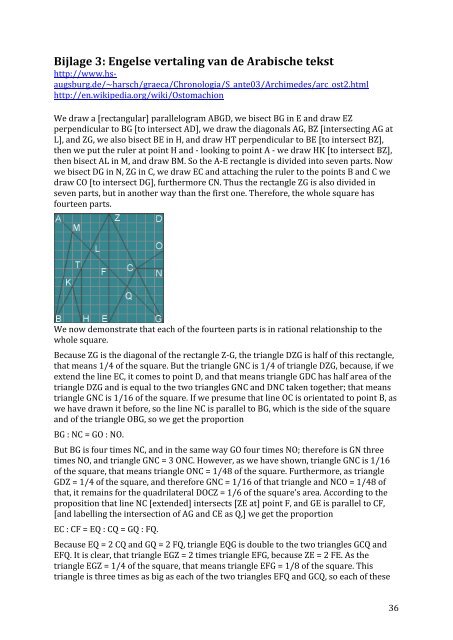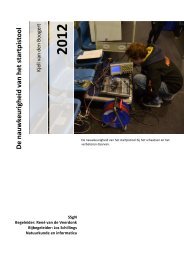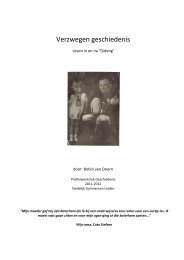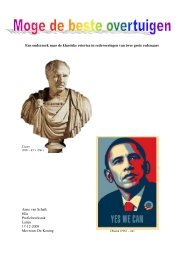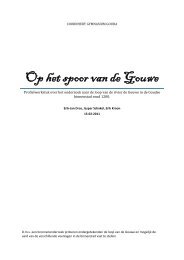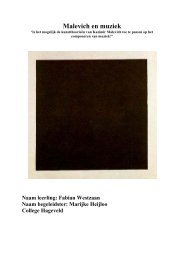Het Stomachion - KNAW Onderwijsprijs
Het Stomachion - KNAW Onderwijsprijs
Het Stomachion - KNAW Onderwijsprijs
Create successful ePaper yourself
Turn your PDF publications into a flip-book with our unique Google optimized e-Paper software.
Bijlage 3: Engelse vertaling van de Arabische tekst<br />
http://www.hs-‐<br />
augsburg.de/~harsch/graeca/Chronologia/S_ante03/Archimedes/arc_ost2.html<br />
http://en.wikipedia.org/wiki/Ostomachion<br />
We draw a [rectangular] parallelogram ABGD, we bisect BG in E and draw EZ<br />
perpendicular to BG [to intersect AD], we draw the diagonals AG, BZ [intersecting AG at<br />
L], and ZG, we also bisect BE in H, and draw HT perpendicular to BE [to intersect BZ],<br />
then we put the ruler at point H and -‐ looking to point A -‐ we draw HK [to intersect BZ],<br />
then bisect AL in M, and draw BM. So the A-‐E rectangle is divided into seven parts. Now<br />
we bisect DG in N, ZG in C, we draw EC and attaching the ruler to the points B and C we<br />
draw CO [to intersect DG], furthermore CN. Thus the rectangle ZG is also divided in<br />
seven parts, but in another way than the first one. Therefore, the whole square has<br />
fourteen parts.<br />
We now demonstrate that each of the fourteen parts is in rational relationship to the<br />
whole square.<br />
Because ZG is the diagonal of the rectangle Z-‐G, the triangle DZG is half of this rectangle,<br />
that means 1/4 of the square. But the triangle GNC is 1/4 of triangle DZG, because, if we<br />
extend the line EC, it comes to point D, and that means triangle GDC has half area of the<br />
triangle DZG and is equal to the two triangles GNC and DNC taken together; that means<br />
triangle GNC is 1/16 of the square. If we presume that line OC is orientated to point B, as<br />
we have drawn it before, so the line NC is parallel to BG, which is the side of the square<br />
and of the triangle OBG, so we get the proportion<br />
BG : NC = GO : NO.<br />
But BG is four times NC, and in the same way GO four times NO; therefore is GN three<br />
times NO, and triangle GNC = 3 ONC. However, as we have shown, triangle GNC is 1/16<br />
of the square, that means triangle ONC = 1/48 of the square. Furthermore, as triangle<br />
GDZ = 1/4 of the square, and therefore GNC = 1/16 of that triangle and NCO = 1/48 of<br />
that, it remains for the quadrilateral DOCZ = 1/6 of the square’s area. According to the<br />
proposition that line NC [extended] intersects [ZE at] point F, and GE is parallel to CF,<br />
[and labelling the intersection of AG and CE as Q,] we get the proportion<br />
EC : CF = EQ : CQ = GQ : FQ.<br />
Because EQ = 2 CQ and GQ = 2 FQ, triangle EQG is double to the two triangles GCQ and<br />
EFQ. It is clear, that triangle EGZ = 2 times triangle EFG, because ZE = 2 FE. As the<br />
triangle EGZ = 1/4 of the square, that means triangle EFG = 1/8 of the square. This<br />
triangle is three times as big as each of the two triangles EFQ and GCQ, so each of these<br />
36


